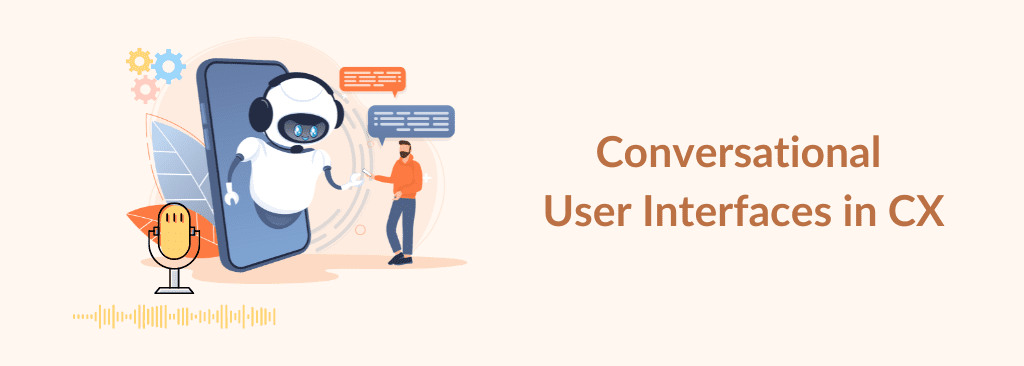The Significance of Conversational User Interfaces (CUIs) In Customer Experience
According to Gartner, Generative AI, conversational user interfaces (CUIs), and digital customer service will transform customer service and support by 2028.
The common theme of these three technologies is their ability to streamline the customer journey and enable customer service leaders to meet customer’s growing expectations, said Drew Kraus, VP Analyst in the Gartner Customer Service and Support Practice.
He further added within the next five years, we expect these technologies to change the face of customer service and support.
In this article, we will look at the significance of conversational user interfaces in the customer experience space.
What Are Conversational User Interfaces (CUIs)?
Conversational user interfaces are human-computer interfaces that enable natural language interactions for the purpose of fulfilling a request, such as answering a question or completing a task.
CUIs facilitate conversations and interactions that mimic human-to-human communication. CUIs encompass various technologies such as chatbots, virtual assistants, voice recognition systems, and messaging platforms, allowing users to interact with computers and services more intuitively and conversationally.
Let us look at some of the reasons why CUIs are used.
What Are the Compelling Cases of CUIs?
1. 24×7 Availability
Unlike human agents, CUIs can operate around the clock, assisting customers outside regular business hours. This allows customers to seek help anytime, improving accessibility and customer loyalty.
Let us assume I want to reschedule my flight booking. I don’t have to wait for regular business hours to talk to an agent. CUIs can help handle my rescheduling request at any time of the day.
2. First-Level Support
Most inquiries that contact centers receive are routine and transactional in nature. They can be resolved through predefined responses or guided interactions.
For instance, I want to know the balance in my account, the status of a check I have sent for clearing, or the last five transactions in my card account – all these are transactional queries that the CUIs can easily handle.
You can even provide your customers with links to knowledge base articles, instructional videos, or interactive guides for customers to self-serve themselves.
This would free human agents to focus on more complex and specialized tasks.
3. Pre-Screening
Conversational interfaces can gather initial customer information before they are connected to a human agent.
For instance, I want to register a complaint with my Internet Service Provider, and I know why the Internet is not working. Due to some construction work in the neighborhood, the cable that leads to my router is cut. This request would require me to talk to a customer.
How does a conversational interface help?
It collects information from me where I say that my Internet is not working, and I also explain why it is not working in additional comments. Now, the CUI intelligently transfers me to the appropriate department within my ISP to handle my request.
Likewise, there are many instances where the CUI can gather all the essential information and make it available for the agents to resolve issues.
4. Appointment Scheduling
Virtual assistants can assist customers in scheduling, rescheduling, or canceling appointments. It can be your physical appointments to visit your physician or set up a time to give you a product demo or other services.
This can be done seamlessly without customers needing to navigate complex scheduling systems.
5. Order Tracking and Status Updates
Customers often want to know the status of orders, shipments, or service requests.
Conversational interfaces can provide real-time updates and tracking information, enhancing transparency and reducing the need for customers to contact the center for updates.
6. Surveys and Feedback Collection
You can use conversational interfaces to gather customer feedback, conduct surveys, and assess customer satisfaction.
It can flag the responses and feedback as positive and negative, allowing you to take immediate steps where there is a need.
7. Scalability and Efficiency
With human agents, you cannot handle multiple interactions simultaneously. Whereas with conversational interfaces, you can handle multiple interactions simultaneously, significantly increasing customer interactions’ efficiency.
It helps you manage high call volumes without long wait times, ensuring customers receive prompt assistance.
8. Personalization and Insights
You can use CUIs to collect and analyze data from customer interactions, providing valuable insights into customer behavior, preferences, and pain points. This can help in informed decision-making.
Besides, you can use customer data to provide personalized recommendations, offers, and solutions, enhancing the overall customer experience.
Overall, conversational interfaces offer contact centers a way to enhance customer experiences, streamline operations, and stay ahead of the competition in a rapidly changing business landscape.
CUIs are potent tools for delivering efficient, personalized, accessible customer support while optimizing costs and resources.
However, balancing automation and human interaction is essential to ensure that customers receive the best possible support across various scenarios.
